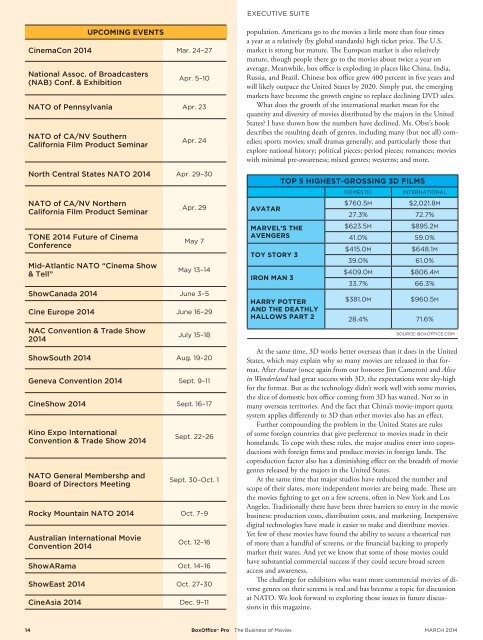You also want an ePaper? Increase the reach of your titles
YUMPU automatically turns print PDFs into web optimized ePapers that Google loves.
EXECUTIVE SUITE<br />
UPCOMING EVENTS<br />
CinemaCon <strong>2014</strong> Mar. 24–27<br />
National Assoc. of Broadcasters<br />
(NAB) Conf. & Exhibition<br />
Apr. 5–10<br />
NATO of Pennsylvania Apr. 23<br />
NATO of CA/NV Southern<br />
California Film <strong>Pro</strong>duct Seminar<br />
Apr. 24<br />
North Central States NATO <strong>2014</strong> Apr. 29–30<br />
NATO of CA/NV Northern<br />
California Film <strong>Pro</strong>duct Seminar<br />
TONE <strong>2014</strong> Future of Cinema<br />
Conference<br />
Mid-Atlantic NATO “Cinema Show<br />
& Tell”<br />
Apr. 29<br />
May 7<br />
May 13–14<br />
ShowCanada <strong>2014</strong> June 3–5<br />
Cine Europe <strong>2014</strong> June 16–29<br />
NAC Convention & Trade Show<br />
<strong>2014</strong><br />
July 15–18<br />
ShowSouth <strong>2014</strong> Aug. 19–20<br />
Geneva Convention <strong>2014</strong> Sept. 9–11<br />
CineShow <strong>2014</strong> Sept. 16–17<br />
Kino Expo International<br />
Convention & Trade Show <strong>2014</strong><br />
NATO General Membershp and<br />
Board of Directors Meeting<br />
Sept. 22–26<br />
Sept. 30–Oct. 1<br />
Rocky Mountain NATO <strong>2014</strong> Oct. 7–9<br />
Australian International Movie<br />
Convention <strong>2014</strong><br />
Oct. 12–16<br />
ShowARama Oct. 14–16<br />
ShowEast <strong>2014</strong> Oct. 27–30<br />
CineAsia <strong>2014</strong> Dec. 9–11<br />
population. Americans go to the movies a little more than four times<br />
a year at a relatively (by global standards) high ticket price. The U.S.<br />
market is strong but mature. The European market is also relatively<br />
mature, though people there go to the movies about twice a year on<br />
average. Meanwhile, box office is exploding in places like China, India,<br />
Russia, and Brazil. Chinese box office grew 400 percent in five years and<br />
will likely outpace the United States by 2020. Simply put, the emerging<br />
markets have become the growth engine to replace declining DVD sales.<br />
What does the growth of the international market mean for the<br />
quantity and diversity of movies distributed by the majors in the United<br />
States? I have shown how the numbers have declined. Ms. Obst’s book<br />
describes the resulting death of genres, including many (but not all) comedies;<br />
sports movies; small dramas generally, and particularly those that<br />
explore national history; political pieces; period pieces; romances; movies<br />
with minimal pre-awareness; mixed genres; westerns; and more.<br />
AVATAR<br />
MARVEL’S THE<br />
AVENGERS<br />
TOY STORY 3<br />
IRON MAN 3<br />
TOP 5 HIGHEST-GROSSING 3D FILMS<br />
HARRY POTTER<br />
AND THE DEATHLY<br />
HALLOWS PART 2<br />
DOMESTIC<br />
INTERNATIONAL<br />
$760.5m<br />
$2,021.8m<br />
27.3% 72.7%<br />
$623.5m<br />
$895.2m<br />
41.0% 59.0%<br />
$415.0m<br />
$648.1m<br />
39.0% 61.0%<br />
$409.0m<br />
$806.4m<br />
33.7% 66.3%<br />
$381.0m<br />
$960.5m<br />
28.4% 71.6%<br />
SOURCE: BOXOFFICE.COM<br />
At the same time, 3D works better overseas than it does in the United<br />
States, which may explain why so many movies are released in that format.<br />
After Avatar (once again from our honoree Jim Cameron) and Alice<br />
in Wonderland had great success with 3D, the expectations were sky-high<br />
for the format. But as the technology didn’t work well with some movies,<br />
the slice of domestic box office coming from 3D has waned. Not so in<br />
many overseas territories. And the fact that China’s movie-import quota<br />
system applies differently to 3D than other movies also has an effect.<br />
Further compounding the problem in the United States are rules<br />
of some foreign countries that give preference to movies made in their<br />
homelands. To cope with these rules, the major studios enter into coproductions<br />
with foreign firms and produce movies in foreign lands. The<br />
coproduction factor also has a diminishing effect on the breadth of movie<br />
genres released by the majors in the United States.<br />
At the same time that major studios have reduced the number and<br />
scope of their slates, more independent movies are being made. These are<br />
the movies fighting to get on a few screens, often in New York and Los<br />
Angeles. Traditionally there have been three barriers to entry in the movie<br />
business: production costs, distribution costs, and marketing. Inexpensive<br />
digital technologies have made it easier to make and distribute movies.<br />
Yet few of these movies have found the ability to secure a theatrical run<br />
of more than a handful of screens, or the financial backing to properly<br />
market their wares. And yet we know that some of those movies could<br />
have substantial commercial success if they could secure broad screen<br />
access and awareness.<br />
The challenge for exhibitors who want more commercial movies of diverse<br />
genres on their screens is real and has become a topic for discussion<br />
at NATO. We look forward to exploring those issues in future discussions<br />
in this magazine.<br />
14 BoxOffice ® <strong>Pro</strong> The Business of Movies MARCH <strong>2014</strong>

















